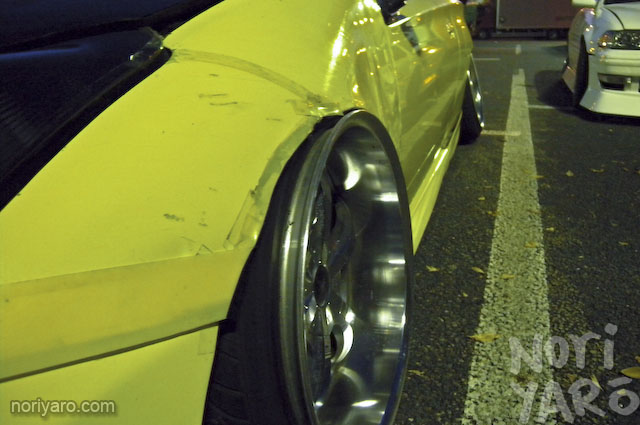|
|
#121 | |
|
Test Whore - Admin
Join Date: Mar 2008
Location: Right Behind you son
Posts: 4,581
Rep Power: 10  |
Quote:
his mobile comedy factories make me want to kill a kitten, torch my FC, slit my wrists and delete the entire thread so that abortion of a thing on 4 non fitting wheels can never be seen on this forum again
__________________
-The Angry Stig- DGRR 2009, 2011, 2012 & 2013 - Best FC DEALS GAP!! WOOHOOOO!!!!! 2015 Audi S4 - Samantha - Zero Brap S4 2004 RX8 - Jocelyn - 196rwhp, 19mpg fuel to noise converter 2000 Jeep Cherokee Sport - Wifey mobile - Now with 2.5" OME lift and 30" BFG AT KO's! So it begins 1998 Jeep Cherokee - 5 spd, 4" lift, 33" BFG's - Rotary Tow Vehicle 1988 'Vert - In progress 1988 FC Coupe - Gretchen -The attention whore BEAST! I'm a sick individual, what's wrong with you? I'm pure Evil I'm still insane, in the best possible way. I think Brian's idea of romance is using lube. Your rage caused the meteor strike in Russia. The Antichrist would be proud of his minion. You win with your thread. Most everything It's a truck with a steel gate on the back. Just a statement of fact Motec M820, AIM dash, ported 13B-RE Cosmo, 6-spd trans, 4.3 Torsen, custom twin wg fully divided mani, Custom 4" split into 2x 3" exhaust, Custom HMIC, Custom custom custom custom I like to welder stuff.... No Bolt-ons allowed. Dyno'ed @ Speed1 Tuned by me - 405rwhp on WG.... WM50 cuming soon. -Angry Motherf*cker Mode ENGAGED- |
|
|
|

|
|
|
#122 | |||||
|
RCC Loves Me Not You
Join Date: Jul 2008
Location: Influx.
Posts: 2,113
Rep Power: 20  |
Quote:
Quote:
Quote:
Quote:
Quote:
__________________
The Official FC Radiator Thread My Project Thread: Cerberus CCVT Virginia Rotary Group |
|||||
|
|

|
|
|
#123 |
|
Haters gonna hate
Join Date: Oct 2008
Location: Charlotte, NC
Posts: 70
Rep Power: 18  |
 Niggas jelly of my mad stretch dawg.  The car is hideous. I can for once understand why he's running retarded negative camber in the rear though, since it's a Front-wheel drive drift car. Less contact patch, no grip, etc etc etc. That stretch on the front though, that is so stupid, I'm sorry. But this guy has daily driven this car like that for years. I don't know how he hasn't killed himself, but yeah. I dunno, my mind was blown when I first saw it.
__________________
If the glove doesn't fit, you must acquit. |
|
|

|
|
|
#124 |
|
Rawr Bearclaw
Join Date: Feb 2008
Location: The Souf
Posts: 197
Rep Power: 18  |
That poor Celica is the most hideous pile of shit I've laid eyes on. And front wheel drive drift car? That's an oxymoron.

__________________
Illicit Performance Rotary building, porting, tuning, chassis dyno services www.illicitperformance.com |
|
|

|
|
|
#125 |
|
Big Ugly
Join Date: Apr 2009
Location: Fredericksburg, Va
Posts: 591
Rep Power: 17  |
There is no excuse for that car being in that condition. The owner should never touch a car again.
__________________
Boosted Big Body On 335's PS3 ID: Rotordad 1986 Mazda RX7 GXL - Street ported 13BT, Haltech, 62mm, ect. 2006 MazdaSpeed 6 - Eagle, Wiseco, Cobb, ect. |
|
|

|
|
|
#126 |
|
Haters gonna hate
Join Date: Oct 2008
Location: Charlotte, NC
Posts: 70
Rep Power: 18  |
Yeah, it is. Funny enough though, he slides that thing better than your average drifter.
__________________
If the glove doesn't fit, you must acquit. |
|
|

|
|
|
#127 |
|
Rotary Fan in Training
Join Date: Mar 2008
Location: Culver City, CA
Posts: 84
Rep Power: 18  |
You know who else slides better than your average drifter?
http://www.motoiq.com/magazine_artic...t-machine.aspx The second photo on the page shows tires that appear to be properly sized. I suspect they have tried quite a few setups, at that level of sponsorship I wouldn't be surprised if they receive literally pallets of tires in the size(s) they request. I'm not a drifter myself, and I generally disagree with the 'hella flush' style. That said, anyone who dislikes drifting should still go check out a Formula D event if you're able to. The paired elimination rounds after the drivers have qualified are a pretty entertaining display of car control and big horsepower. The cars aren't as cool a ALMS, but the track is set up in a way that makes it a really good spectator event (even compared to roadracing or NASCAR). |
|
|

|
|
|
#128 |
|
Haters gonna hate
Join Date: Oct 2008
Location: Charlotte, NC
Posts: 70
Rep Power: 18  |
Difference is, that's a front-wheel drive Celica, versus Foust's rear-wheel drive car with three times the horsepower, not to mention Kawashima (the guy that owns the Celica) isn't a pro. Not defending the looks or stretch, I'm just saying, totally not fair to compare the two.
Only certain guys, even at a pro level, have a selection like that, ie. All the Falken guys. Double stacker full of tools and tires. At any rate. There are still a lot of "herrafrush" cars in Formula D. Tanner's car is set up like that, because he didn't build it. He just drives it, that's it. Same goes for 90% of the other Formula D drivers.
__________________
If the glove doesn't fit, you must acquit. |
|
|

|
|
|
#129 |
|
The Newbie
Join Date: Dec 2010
Posts: 29
Rep Power: 0  |
Vex,
Okay, I can see how I misinterpreted the MoS thing. The point about not being at max load wasn't as much a reference of the fact that it determines the whole criteria, but that it plays a role in the original engineering specifications. When I say that it's not at its maximum rating on an average vehicle I'm just saying that if it isn't at it's maximum load then changing the load (large assumption here) might have some wiggle room. <-I know there's no way you'll concede to that point. I had to read the gun reference a couple times to pick up the point you were making there, still not 100% sure I understand what you're saying about the non-firing round. (I'm not a gun person, I stay away from them.) I did understand the brake master reference. That's an excellent reference for anyone that has driven with a leaking brake master. I could definitely see how the two correlate. That's your best argument yet for real world relation IMO. (this was the thing I was trying to do previously with coffee and baseball bat references, it's hit and miss sometimes with metaphors) Your reply of "Not really" is the point I've been trying to make the whole time. If you didn't see ANY validity in what I said you would've answered "No", but you did see some truth in what I'm saying. You don't agree with it as being safe by engineering standards, but obviously have to accept that the possibility that it will hold is true. I am willing to more directly concede. My only point this whole time was to get acknowledgement that it's possible it's safe (from a standard of holding for the life of the tire). I'm not saying it is, I agreed with your statements of material sciences from the get-go and agree that there will be deformation on the tire. All I've argued is that it's possible that it will hold and get you safely from point A to point B for the life of the tread. I understand your stance of safety and agree that there is definitely a possibility that it could fail as well based on using it outside of its designed specifications. For the vulcanized rubber, where am I looking this up and what types of numbers am I looking for? And as for the VIP Celica... that thing is awful. Also, there's no way I'd be willing to stretch a tire that far. I am definitely not arguing for what that guy is doing. That shit is wrong on so many levels. |
|
|

|
|
|
#130 |
|
The Newbie
Join Date: Dec 2010
Posts: 29
Rep Power: 0  |
With Rotary's point Tanner's car has a NASCAR V8 under the hood. That thing has so much torque he has to jam the widest tires he can on it to have a possibility of control, not to mention the whole "purpose built race car" thing.
Look at the guys like Mad Mike Whiddett, or Matt Powers if you want to see the "style" stuff. The guys in there with big sponsors that don't wrench on thier own cars aren't the guys that everyone shows up to watch. The guys we want to see and are cheering for are the guys with blood sweat and tears into thier car. The sport would fail if it weren't for the little guys that are still about style in my opinion. The whole sport is based on style, cars like Sam Hubinette's Dodge Challenger look like sore thumbs. If you spend NO time working on style and everything on engineering the best car in a series based on style no one will root for you. Sure he's a good driver, but I can see a car like at the dealership. Big MEH, not interesting to look at, watch, and doesn't draw you in. At least Tanner's car is widebody and some cool engineering went into converting it to RWD. It's not all about the tire stretch, it's just one of many factors of style. 
|
|
|

|
|
|
#131 | ||||
|
RCC Loves Me Not You
Join Date: Jul 2008
Location: Influx.
Posts: 2,113
Rep Power: 20  |
Please quote my previous response as it makes things easier to keep track of.
Quote:
Quote:
Quote:
Quote:
http://www.matweb.com/search/DataShe...ff3f5da&ckck=1 We want the mechanical properties.
__________________
The Official FC Radiator Thread My Project Thread: Cerberus CCVT Virginia Rotary Group |
||||
|
|

|
|
|
#132 |
|
Haters gonna hate
Join Date: Oct 2008
Location: Charlotte, NC
Posts: 70
Rep Power: 18  |
Sam's car is kinda ugly yeah, but he's cool as fuck.
So I forgive him.
__________________
If the glove doesn't fit, you must acquit. |
|
|

|
|
|
#133 | |||
|
The Newbie
Join Date: Dec 2010
Posts: 29
Rep Power: 0  |
Quote:
Quote:
http://www.matweb.com/search/DataShe...0718874&ckck=1 I didn't see a way to post it here that would be easy to read so I separated the fields using astrix.. Quote:
|
|||
|
|

|
|
|
#134 |
|
Rotary Fanatic
Join Date: Feb 2008
Location: Gresham, OR
Posts: 473
Rep Power: 18  |
im no expert here, but is it really the rubber thats going to fail?
i would expect failure either from the bead unseating or bands in the sidewall breaking. thats kinda the point of the bands, to hold the rubber together... this whole 'preoperties or rubber' argument seems pretty pointless considering theres much more than that to a tire.
__________________

|
|
|

|
|
|
#135 |
|
The Newbie
Join Date: Dec 2010
Posts: 29
Rep Power: 0  |
I'm not sure where this is headed at the moment either. I'm sure I'll learn something here... not sure what yet.
I doubt it's going to change anything in the discussion; I'm continuing in the purpose of learning something about material science. Obviously there are WAY more factors involved here than just the rubber. |
|
|

|
 |
| Bookmarks |
|
|